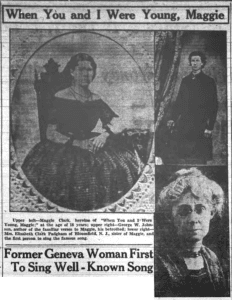The Padgham Family
By Becky Chapin, Archivist
Richard W Padgham was born on April 11, 1850 in Barbados, West Indies to the Rev. Henry and Eleanor (Appleton) Padgham of England. He obtained his degree in medicine in London, but followed in his father’s footsteps and became a minister after moving to Canada where he held a pastorate. Here he met Elizabeth Clark. Elizabeth was born on June 12, 1851 in Glanford, Ontario.

Images of Maggie and Elizabeth Clark, and George Johnson from Geneva Daily Times, November 30, 1932.
Elizabeth’s sister Maggie was attending their local school when she met George Johnson, a newly graduated instructor. George was described by Elizabeth as a striking looking man with dark, curly hair while Maggie, “a belle of her time,” had soft blonde ringlets. They often took strolls together which took them to an old saw mill, near her home, on the bank of creek. A romantic spot shaded by tall maple trees. During this courtship, George wrote a volume of poems called “Maple Leaves” which included a poem called “When You and I Were Young.”
Maggie and George were married on October 21, 1864, and they moved to Cleveland, Ohio where George became the associate editor of the Cleveland Plain Dealer. Less than a year later, Maggie died on May 12, 1865. George returned to Canada and became a math professor at the University of Toronto.
In 1866, George had his poem set to music by JA Butterfield of Detroit. He brought the music home to Maggie’s family and Elizabeth remembers singing “When You and I Were Young, Maggie” with one of her younger sisters.
In 1874, Elizabeth married Richard Padgham. They moved a few times, living in Pennsylvania and Odessa, New York until they moved to Geneva in 1897. Richard opened his medical office at 305 Main Street before moving it to 159 Genesee Street. Here he practiced medicine until his death in 1911 at age 61.

Sheet Music for “When You and I Were Young, Maggie?” from Special Collections and College Archives, Musselman Library, Gettysburg College
Together they had five children, Ethelbert Guthrie, Eleanor (who died as a child), Mabel, Maud, and Leila Blanche. After Richard’s death, Elizabeth moved with her three daughters to Bloomfield, NJ and then in 1943 to Canisteo. Here Elizabeth lived out her life until her death in 1947 at age 96.
Ethelbert was born in Odessa on May 9, 1875. While he started out as a teacher in the Fayette-Interlaken area, he also decided to follow in his father’s footsteps when he obtained a medical degree from the Cincinnati Medical College in 1906. Dr. Padgham first opened his practice in Seneca Falls in 1907, then moved to Exchange Street in Geneva in 1908. He moved into his father’s office after Richard’s death. In 1935, his last move was to 164 Genesee, taking over the office of Dr. Theodore D Ruppert.
In his 80s, he gave an interview to Dr. John Stelter who recorded their conversation and donated the tape to Historic Geneva. I enjoyed their discussion on the advances in medical practices. Dr. Padgham talked about various diseases that came through Geneva. In 1912, an epidemic of typhoid fever swept the area followed by cholera which resulted in numerous deaths. Advances in refrigeration and sanitation wiped out these diseases. He remembered the 1918 influenza epidemic which caused many local doctors to quit. He believes he was the second hardest working doctor after Dr. Neider. They treated patients in their home instead of bringing them to the hospital to prevent spreading the virus.
A 1920s diphtheria outbreak saw the start of regular immunizations for children. Dr. Padgham attributed immunizations as the reason diphtheria was eradicated locally. He also worked through the 1944-45 polio outbreak.
In 1923, Dr. Padgham was a charter member of the Geneva Academy of Medicine which was formed after the separation of the Geneva General Hospital staff from the private physicians around town. He served as its president in 1940. He became a physician and anesthesiologist for the Geneva General Hospital in the 1940s while maintaining his practice at Genesee Street.
As a general practitioner, Dr. Padgham began making his rounds on horseback, got a bicycle, and eventually a Model T for $400. In an interview with the Geneva Daily Times, he said after the Ford he “got a Plymouth which I drove for about 80,000 miles. These two cars are gone, the horse is dead, but that bicycle is around here somewhere.”
In 1956, he was recognized for 50 years of devoted service to the public by the Medical Society of the State of New York. A week after he retired, Dr. Padgham died in 1971 at age 96.
This article was brought to you in part by our supporters. Be our partner in telling Geneva’s stories by becoming a Historic Geneva supporter.


Becky, Great Article. Great to use Dr. Stelter”s tapes. Never thought they would be used!